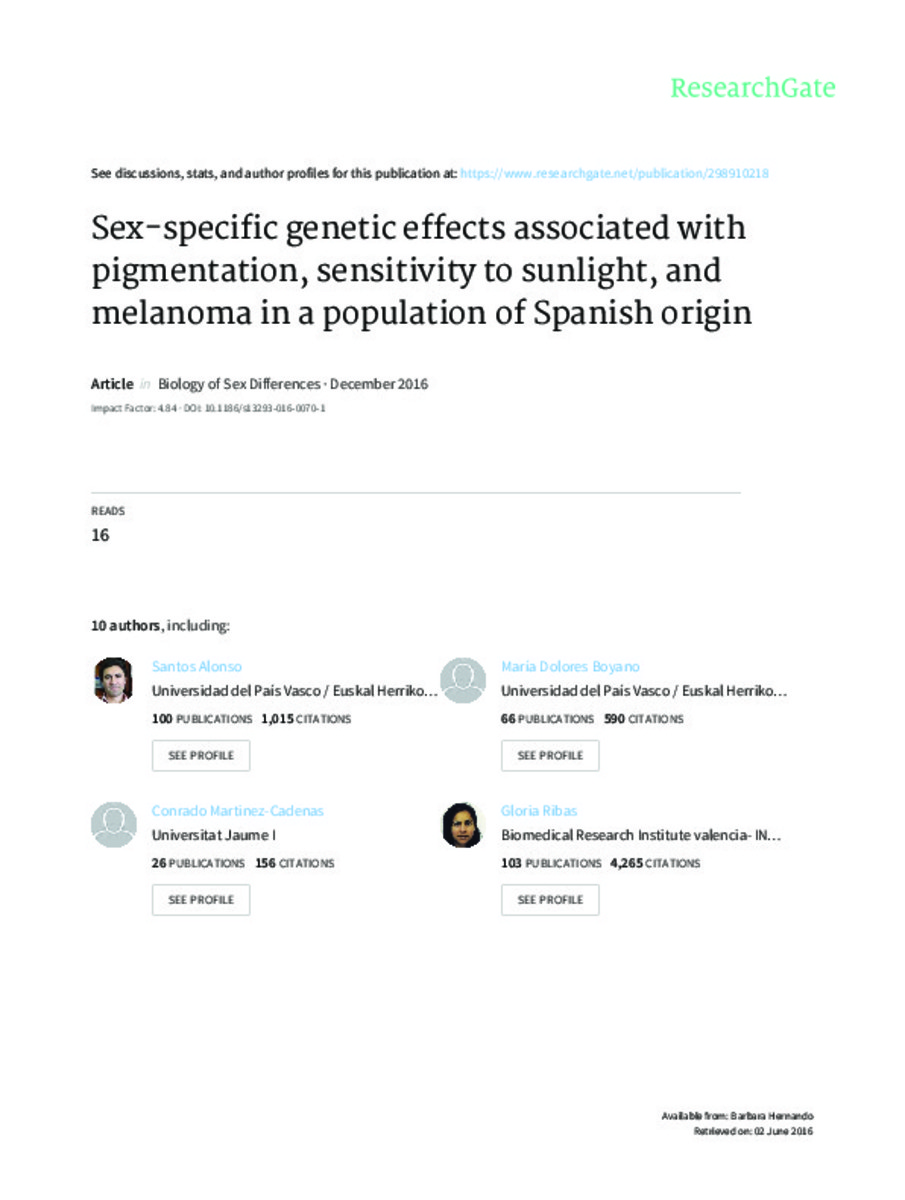Mostrar el registro sencillo del ítem
Sex-specific genetic effects associated with pigmentation, sensitivity to sunlight, and melanoma in a population of Spanish origin
| dc.contributor.author | Hernando, Barbara | |
| dc.contributor.author | Ibarrola-Villava, Maider | |
| dc.contributor.author | Fernández, Lara P. | |
| dc.contributor.author | Peña Chilet, María | |
| dc.contributor.author | Llorca-Cardeñosa, Marta J. | |
| dc.contributor.author | Oltra, Sara S. | |
| dc.contributor.author | Alonso, Santos | |
| dc.contributor.author | Boyano, Dolores | |
| dc.contributor.author | Martinez-Cadenas, Conrado | |
| dc.contributor.author | Ribas, Gloria | |
| dc.date.accessioned | 2016-06-02T11:08:48Z | |
| dc.date.available | 2016-06-02T11:08:48Z | |
| dc.date.issued | 2016-03 | |
| dc.identifier.citation | Hernando, B., Ibarrola-Villava, M., Fernandez, L. P., Peña-Chilet, M., Llorca-Cardeñosa, M., Oltra, S. S., ... & Ribas, G. (2016). Sex-specific genetic effects associated with pigmentation, sensitivity to sunlight, and melanoma in a population of Spanish origin. Biology of sex differences, 7(1), 1. | ca_CA |
| dc.identifier.uri | http://hdl.handle.net/10234/160265 | |
| dc.description.abstract | Background Human pigmentation is a polygenic quantitative trait with high heritability. In addition to genetic factors, it has been shown that pigmentation can be modulated by oestrogens and androgens via up- or down-regulation of melanin synthesis. Our aim was to identify possible sex differences in pigmentation phenotype as well as in melanoma association in a melanoma case-control population of Spanish origin. Methods Five hundred and ninety-nine females (316 melanoma cases and 283 controls) and 458 males (234 melanoma cases and 224 controls) were analysed. We genotyped 363 polymorphisms (single nucleotide polymorphisms (SNPs)) from 65 pigmentation gene regions. Results When samples were stratified by sex, we observed more SNPs associated with dark pigmentation and good sun tolerance in females than in males (107 versus 75; P = 2.32 × 10−6), who were instead associated with light pigmentation and poor sun tolerance. Furthermore, six SNPs in TYR, SILV/CDK2, GPR143, and F2RL1 showed strong differences in melanoma risk by sex (P < 0.01). Conclusions We demonstrate that these genetic variants are important for pigmentation as well as for melanoma risk, and also provide suggestive evidence for potential differences in genetic effects by sex. | ca_CA |
| dc.description.sponsorShip | We thank the Madrid College of Lawyers and all patients from the different contributing Hospitals. We would like to thank Tais Moreno, M. Rosario Alonso, and Guillermo Pita for their expert technical assistance with Illumina genotyping, performed at the Spanish National Genotyping Centre (CeGen, Madrid). MI-V is funded by the “Ministry of Health Carlos III” under a Sara Borrell contract (CD15/00153). ML-C is funded by a Prometeo contract (2015/005). SSO is funded by the “ Ministry of Education, Culture and Sport” under a FPU fellowship (FPU13/04976). GR is funded by the “Ministry of Health Carlos III” under a Miquel Servet II contract (CPII14-00013). This work has also been partly funded by a research project from the Spanish Ministry of Economy and Competitiveness (CGL2014-58526-P), whose principal investigator is SA | ca_CA |
| dc.format.extent | 9 p. | ca_CA |
| dc.format.mimetype | application/pdf | ca_CA |
| dc.language.iso | eng | ca_CA |
| dc.publisher | BioMed Central | ca_CA |
| dc.relation.isPartOf | Biology of sex differences, 7(1), 2016 | ca_CA |
| dc.rights | © 2016 BioMed Central Ltd unless otherwise stated. Part of Springer Science+Business Media. | ca_CA |
| dc.rights | Attribution 4.0 Spain | * |
| dc.rights.uri | http://creativecommons.org/licenses/by-sa/4.0/ | * |
| dc.subject | pigmentation | ca_CA |
| dc.subject | UV sensitivity | ca_CA |
| dc.subject | skin cancer | ca_CA |
| dc.subject | sex polymorphisms | ca_CA |
| dc.title | Sex-specific genetic effects associated with pigmentation, sensitivity to sunlight, and melanoma in a population of Spanish origin | ca_CA |
| dc.type | info:eu-repo/semantics/article | ca_CA |
| dc.identifier.doi | http://dx.doi.org/10.1186/s13293-016-0070-1 | |
| dc.rights.accessRights | info:eu-repo/semantics/openAccess | ca_CA |
| dc.relation.publisherVersion | https://bsd.biomedcentral.com/articles/10.1186/s13293-016-0070-1 | ca_CA |
| dc.type.version | info:eu-repo/semantics/publishedVersion |
Ficheros en el ítem
Este ítem aparece en la(s) siguiente(s) colección(ones)
-
MED_Articles [636]
Articles de publicacions periòdiques








